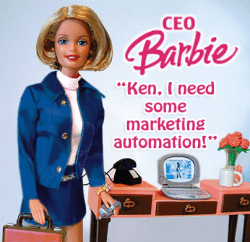How Marketing Automation Can Help your Marketing Team Achieve More with Less
Trying to figure out how marketing automation can help? Before we start off with the details and get into complications, let’s get a clear perspective about what marketing automation is, it’s a process to replace repetitive, ‘manual’ actions which involve excessive human interaction with automated solutions to streamline the marketing processes within an organization. Let’s consider a bottling factory. Before automation, the plant had about 300 workers on their payroll bottling 3000 bottles an hour – after installation of a machine the rate jumped to 100,000 bottles in 30 minutes. Net effect? Increased productivity. What the plant did was to ‘automate’ a clearly manual process with the help of a machine which essentially is an example of what marketing automation is – a naive one perhaps.
The focus in automating your company’s marketing tasks is on moving leads from the top of the marketing funnel through to becoming sales-ready leads at the other end of the funnel. Prospects are scored, based on their activities and then presented drip campaign messaging via email and social channels, thus nurturing them from first interest through to the final nod. Marketing automation may be applied within the company’s infrastructure for many purposes, some of which may be:
• Designing and running email marketing campaigns
• Automation of repetitive, inherently manual business tasks
• Developing an automated campaign to increase visibility and hence sales
• Ideally suited for low-budget SMEs
I should clarify here that marketing automation is not a product category, rather, it’s a lose definition of products that help marketing teams reach out to ever greater numbers, qualify leads and run their marketing campaigns that yield better results.
One primary benefit your marketing team can immediately reap from putting in place an easy-to-use marketing automation service (not software, but a service) will be an increase in the number of quality leads given to your sales staff. The definition of ‘quality’ here is essentially iterative since it would vary from team to team, organization to organization. Lead qualification is something that can definitely increase your sales team’s efficiency and eventually, your sales!
In addition to ‘implementing’ marketing tasks, you can also ‘measure’ your marketing activities. No one does blind marketing anymore, specially with tight budgets. Automation tools can help you track your marketing expense e.g. on online advertising networks like Google Adwords. Measuring your online marketing campaign will equip your marketing team with the right data to tweak their future campaigns for improved penetration and eventually, more conversions.
The world of desktop software for marketing management has largely been replaced with web based services, hosted and served from the ‘Cloud’. These services are sold as subscriptions following the SaaS model. This has clear advantages over software installed on workstations/laptops. First, you don’t need any installation, all you need is a subscription to the service and you’re good to go.
SaaS has now become a common IT services delivery method for many organizations – either big or small. It is adaptable for many business models such as accounting, collaboration, customer relation and human resource management. One of the key features of SaaS is that companies no longer have to spend resources on IT as they can simply subscribe to SaaS providers. They can provide readymade structures – ready to be integrated into your home grown systems.












